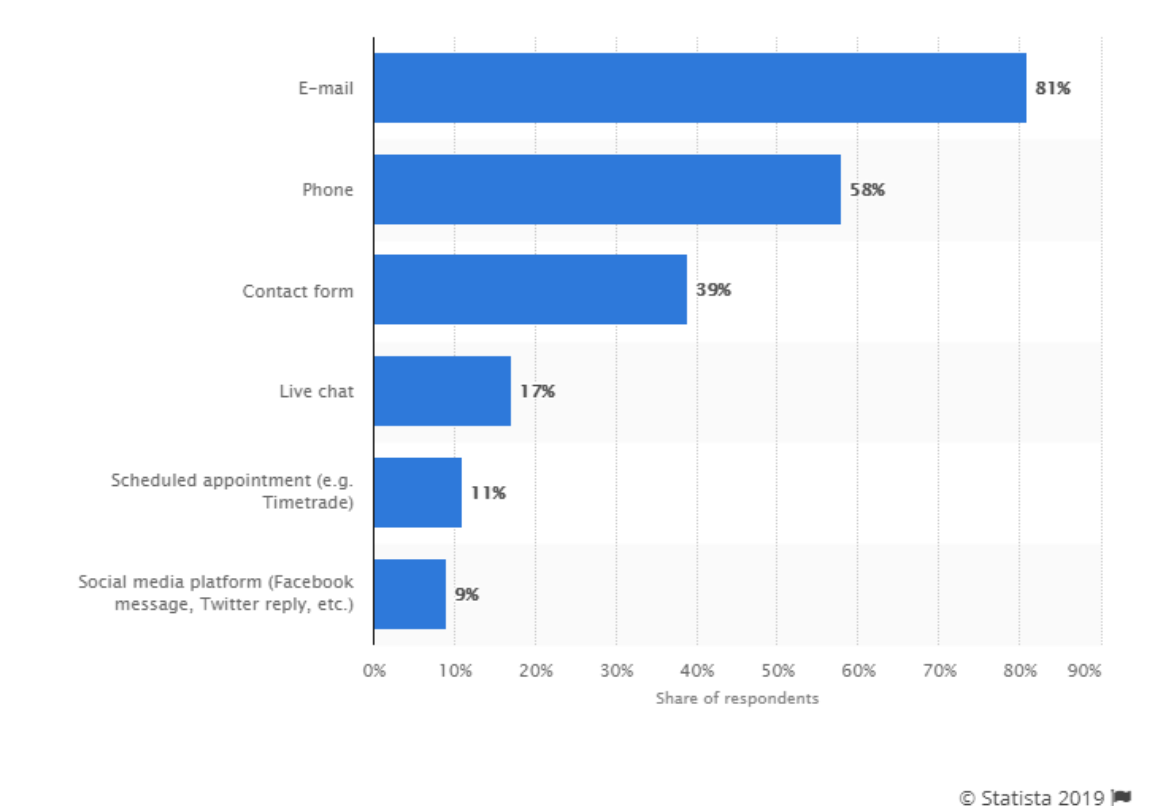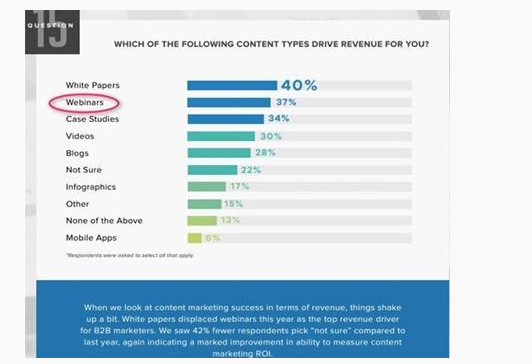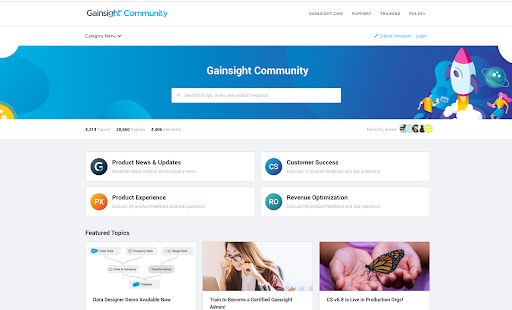Originally published on inSided.com on November 26, 2019.
Good communication is vital if you want to improve your company’s bottom line and grow your business. When you communicate well with customers, your chances of success in business increase exponentially. Check out this guest blog from Omnisend on the best strategies for successful B2B customer communication.
B2B companies use various marketing communication tools to retain existing customers, connect with new customers, and focus on turning prospective customers into sales. There are a whole host of ways of spreading the message—emails, webinars, live chats, communities and contact forms, to name but a few!
But the most important thing to keep in mind? You must ensure that communication with your B2B prospects or customers takes place on their preferred channels.

Check out the stats in the diagram above showing the preferred customer 1-way communication channels for contacting B2B vendors in the United States.
For instance, if a customer or a prospect sends you a Facebook message, they expect a response on the same platform—and soon. If you don’t respond quickly, they’ll probably go to your competitor, who probably offers better customer service and at least responds to inquiries on time.
Top Tips and Channels for Effective B2B Customer Communication
1. Email Marketing
Have a new blog post or an update to share with your customers? Emails work well as an essential CRM tool, helping you to retain as well as gain customers. Well executed, targeted email campaigns to potential customers in the market, or regular e-newsletters can effectively help you engage and stay in touch with existing and potential customers.
You can also create email autoresponders to send welcome or thank you emails to customers. While autoresponders can be scheduled, they offer a more personal one-on-one style of communication that allows you to develop your relationships with customers without your sales and marketing teams having to put in much effort.
And according to Forrester Research, companies that use email to nurture leads make 50% more sales-ready leads at 33% lower cost.
2. Webinars:
Companies usually use webinars to demonstrate products and services, expand on content published in a blog post, and showcase their expertise.
Webinars typically consist of a presentation from a Subject Matter Expert followed by a Q&A session. They can help you connect quickly with participants and are great for retaining attention as it is a visual medium. As per MakeSocialMediaSell, webinars manage to retain 40% of viewers’ attention. Plus, most people tend to grasp information faster when it is presented visually rather than written down.
As per the Demand Wave report, webinars are one of the top content types that prove to drive revenue for B2B brands. They contribute to successful sales funnels and contribute to pipeline—getting attendees interested in buying products and services.

Top content types that drive revenue for your brand
In fact, according to Branded Solopreneur, between 2% and 5% of webinar attendees will buy something from you!
3. Communities
Your B2B company needs a community. As per Mary Green, a community-building specialist, a user community is vital as it brings people together and increases their trust in your brand. Community helps to keep people loyal, makes them feel like they matter, and it also allows the company to show how much they appreciate their customers. You can also offer one-to-one support, or one-to-many advice whenever it’s needed. Online communities can actually reduce support tickets by up to 50%, freeing up valuable time for your Customer Support and Success teams.
In fact, over 85 percent of Fortune 500 companies rely on their communities to identify customer needs. You can of course build your B2B customer community on social media sites like Facebook, LinkedIn, or Twitter. But if you are looking to build a community that’s totally secure and owned solely by your organization, you can opt for tools that allow you to create a B2B community of your own.
Check out the community from Customer Success giants, Gainsight. Here Gainsight combine their public knowledge base with an online community so that users can assist each other, solve problems and learn new things about the product. Users can also benefit from company created content that can be easily found in just a few clicks.

You will also find product-centric areas for troubleshooting, as well as general business discussions. Of course, the company representatives also actively participate in the community. One of the greatest advantages of the Gainsight community is that product managers can get invaluable feedback from everyday users on where they would like to see changes and improvements to the product. Who better to give you feedback on your product than those who use it everyday?
4. Live chat
Live chat on your website can allow visitors to connect with representatives on demand and get answers to their queries instantly. Live chat is different from traditional support channels in that it has the ability to engage customers in real-time. It’s perfect for those customers who dread picking up the phone and want instant solutions without needing to call—but remember that the time and resources your company needs to invest in remains the same!
Live chats allow agents to handle several chats at the same time and offer better opportunities to use interaction logs for continuous improvement purposes. In one particular survey, 75% of respondents stated they would prefer to live chat. In addition, you will find it easier to search for, and correct, service issues from text-based chat logs than from voice interactions.
Live chats can also increase your top-line revenue. You will gain new insights into browsing habits and customer personas, allowing you to provide personalized interactions throughout the customer journey. With live chat, you can be present at just the right time and place to assist them in purchasing or solving problems with your product.
5. Contact forms
One of the most crucial areas of any B2B organisation’s website is their contact page. Apart from offering the information your B2B customers are looking for, contact forms also build trust with your prospective customers.
In a survey, 55% of respondents said that missing contact information/phone number reduces a vendor’s credibility, while 52% of respondents reported that detailed contact or ‘About’ information establishes a vendor’s credibility.
Top tip: Ensure that the right form shows up at the right time in a relevant context on your website. Forms can build customer communication, increase engagement rates, and open up a dialogue with potential customers—but they need to be strategically placed on your site!
Don’t forget: allow your audience to self-serve!
We live in an age where customers have a lot of control. The leap to digital has increased competition across B2B SaaS. Customers today not only compare the service that you offer to the best out there, they demand that service providers be there on the channels of their liking. But more often than not they prefer to be able to find answers on their own.
This is where it’s so important that your organisation facilitates effective customer self-service. When looking for answers to their questions about your product, why should users be required to contact your Support team when the answer they need could be easily found on an online community or knowledge base, for example? Encouraging self-service reduces pressure on your teams while speeding up response times for your customers, all the while making sure users have the tools they need to get the most from your product. In a nutshell, customers don’t just want to be able to self-serve—they expect it.
Of course, no matter which channels you choose to suit your customer base and build communication with your customers, it is vital to equip your agents with tools and insights to support your customers better.
Consider integrating all these elements to provide your agents with a clearer view of your customer base to open up new possibilities for you to effectively sell and serve your customers.
As stated in B2B International, most businesses lose 45 to 50 percent of their customers every five years. If that doesn’t highlight the importance of the need for effective B2B communication for customer retention then nothing will! It’s crucial for B2B companies to place customers at the center of every aspect of their business. Remember that, without happy customers, your business will struggle to achieve the rest of its goals.
Of course there are a whole host of ways to increase B2B customer retention—check out this eBook for more strategies!
Learn More
Looking create a single destination for your customers to connect, share best practices, provide feedback, and build a stronger relationship with your product? Schedule a demo to learn more.

